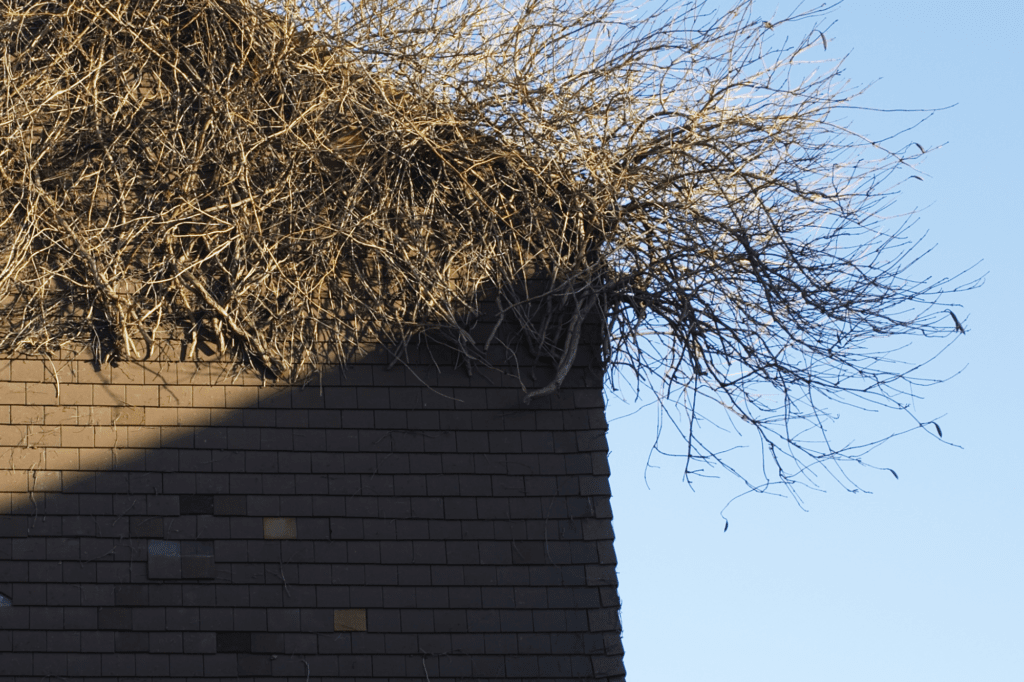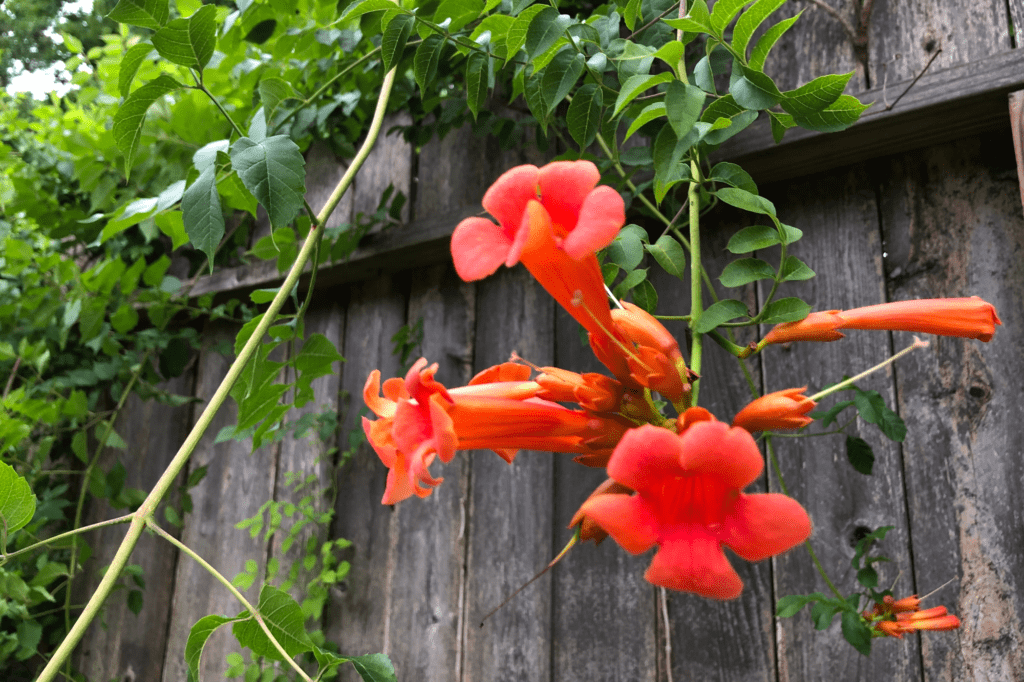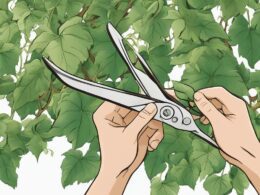- Properly assessing the condition of your trumpet vine is crucial in determining if it’s indeed dead.
- Common signs of a dead trumpet vine include a lack of new growth, brown leaves, and the absence of flowers.
- Reviving a dead trumpet vine can involve techniques such as pruning, providing proper care, and understanding common issues that lead to a dead or dying trumpet vine.
Signs of a Dead Trumpet Vine
If you suspect your trumpet vine might be dead, there are several signs you can look for to confirm your suspicions. Here are some common indicators:
Here are some common indicators:
| Signs of a dead trumpet vine: | What it means: |
|---|---|
| No signs of life | If you see no new growth, leaves, or blooms, it could indicate that your trumpet vine is dead. |
| Dry and brittle stems | If the stems of your trumpet vine are dry, brittle, or snap easily, it could mean it’s dead. |
| Black or brown discoloration | If you notice black or brown discoloration on the vines or leaves, it could be a sign of fungus or disease, which could cause your trumpet vine to die. |
| No green tissue | If you don’t see any green tissue in the stems, it could indicate that the trumpet vine is dead. |
Assessing the Health of Your Trumpet Vine
Before determining if your trumpet vine is dead, it’s important to assess its overall health. There are several factors to consider when evaluating your plant, including trunk and root health, foliage condition, and blooming patterns.| Factor | Signs of Health | Signs of Poor Health |
|---|---|---|
| Trunk & Root Health | Sturdy, solid base Roots are firm and unyielding to touch | Sunken, soft or rotted trunk/base Roots are soft, mushy or have a foul odor |
| Foliage Condition | Bright green leaves Smooth, firm texture No yellowing or brown spots | Wilting or drooping leaves Yellowing or brown spots Holes or pests |
| Blooming Patterns | Yearly blooming cycles Flowers are vibrant and plentiful | No blooms or late/infrequent blooming Few flowers or muted colors |
Reviving a Dead Trumpet Vine
If your trumpet vine appears to be dead, don’t give up hope! There are a few things you can do to attempt to revive it.
Assess the Damage
Before you can revive a dead trumpet vine, you first need to assess the extent of the damage. If the plant is completely withered and dried out, it may be beyond saving. However, if there is still some life in the roots or stem, you may be able to revive it.Prune the Dead Parts
The first step in reviving a dead trumpet vine is to prune away any dead or damaged parts. This will help the plant focus its energy on the healthy parts and encourage new growth. Use sharp pruning shears to cut away any dead branches or stems.Water and Fertilize
Once you’ve pruned away the dead parts, it’s time to give your trumpet vine some TLC. Water the plant deeply, making sure to saturate the soil. You may also want to fertilize the plant with a balanced fertilizer to promote new growth.Provide Plenty of Sunlight
Trumpet vines love sunlight, so make sure your plant is getting plenty of it. Find a sunny spot for your plant and avoid placing it in areas with too much shade.Be Patient
Reviving a dead trumpet vine is not a quick process, and it may take some time for new growth to appear. Keep caring for your plant, and don’t give up hope too soon! If after a few weeks you still see no signs of life, it may be time to accept that your trumpet vine is truly dead. But with a little patience and TLC, you may be able to bring your trumpet vine back to life and enjoy its beautiful blooms once again.Saving a Dying Trumpet Vine
If you notice that your trumpet vine is not thriving as it should, it may be in a weakened state. However, with the right care, you can bring it back to life. Follow these tips to save your dying trumpet vine.Watering
One of the most important factors in reviving a dying trumpet vine is proper watering. Ensure that you water it deeply and frequently, especially during hot and dry weather. If the soil feels dry to the touch, that’s a sign that it needs watering.Fertilizing
Another crucial factor in saving a dying trumpet vine is providing the right nutrients. Fertilize your plant with a balanced fertilizer every two weeks during the growing season.Pruning
Pruning is also essential in reviving a dying trumpet vine. Remove any dead or damaged branches, as well as any growth that looks unhealthy. This will encourage new growth and promote overall plant health.Sunlight
Trumpet vines need full sun to thrive. Ensure that your plant receives at least six hours of sunlight every day.Pests and Diseases
Insects and diseases can also weaken a trumpet vine. Keep an eye out for any signs of infestation or disease, and treat them promptly. By providing the right care and attention, you can save your dying trumpet vine and enjoy its beautiful blooms for years to come.Troubleshooting a Dead Trumpet Vine
If you have tried to revive your trumpet vine and have had no success, it’s important to troubleshoot the issue and understand what may have caused its demise. Here are some common issues to consider:| Issue | Cause | Solution |
|---|---|---|
| No blooms | Insufficient sunlight, over-fertilization, improper pruning | Ensure your trumpet vine receives sufficient sunlight, avoid over-fertilization, and properly prune the plant. |
| Foliage withering | Under-watering, overwatering, poor drainage, nutrient deficiencies | Properly water your trumpet vine, ensure proper drainage, and address any potential nutrient deficiencies. |
| Disease or pest infestation | Bacterial or fungal infections, pests such as spider mites or whiteflies | Identify any potential disease or pest issues and take appropriate measures to treat and prevent future outbreaks. |
Pruning a Dead Trumpet Vine
If your trumpet vine is dead, pruning it becomes essential to encourage new growth. Follow these steps to properly prune a dead trumpet vine:- Assess the vine: Determine which parts of the plant are dead by looking for brown or black foliage, brittle stems, and a lack of buds or blooms. Use pruning shears to remove any dead or diseased branches.
- Cut back the remaining branches: Once you have removed the dead branches, it’s time to cut back the remaining branches to promote new growth. Look for healthy buds on the remaining branches and cut just above them at a 45-degree angle. Be sure to leave at least two healthy buds on each branch to ensure new growth.
- Thin out the plant: If the trumpet vine is especially overgrown, thin out the remaining branches to allow for new growth. Trim back any branches that are crossing or rubbing against each other, and remove any branches that are growing in the wrong direction.
- Dispose of trimmed branches: Once you have finished pruning your trumpet vine, dispose of the trimmed branches properly. Do not compost any diseased or dead branches, as this can spread diseases to other plants.
Can Salt be Used to Kill a Trumpet Vine?
Using salt to kill a trumpet vine is not recommended as it may harm surrounding plants and disrupt the soil’s balance. Salt and trumpet vine compatibility is poor, and salt application can lead to toxicity, causing leaf burn and inhibiting growth. It’s better to explore alternative methods for controlling this vigorous plant.
Tips for Reviving a Trumpet Vine
If your trumpet vine is wilted or dead, there are some steps you can take to bring it back to life. Here are some tips to help you revive your trumpet vine:- Prune the dead parts: Use pruning shears to remove any dead or damaged branches, stems, or leaves. This will help redirect the plant’s energy to new growth.
- Water properly: Water your trumpet vine deeply and regularly, especially during dry spells. Avoid letting the soil become too dry or too wet, as both can harm the plant.
- Fertilize: Use a balanced fertilizer with equal amounts of nitrogen, phosphorus, and potassium to help stimulate new growth. Apply it once a month during the growing season.
- Provide sunlight: Trumpet vines prefer full sun exposure, so make sure they receive at least 6-8 hours of direct sunlight per day.
- Improve soil: If the soil is poor, amend it with organic matter such as compost or aged manure. This will help improve drainage and provide nutrients for the plant.
- Train the vines: As the trumpet vine grows, train it to climb a trellis or other support structure. This will help it grow upright and prevent it from sprawling all over the place.
- Be patient: Reviving a trumpet vine takes time and patience. Don’t expect results overnight, but with proper care, your plant should eventually bounce back.
Conclusion
Reviving a dead or dying trumpet vine may seem like a daunting task, but with the right care and attention, it’s often possible to bring it back to life. By assessing the health of your plant, identifying signs of a dead trumpet vine, and following the tips and techniques provided in this guide, you’ll have a better chance of saving your beloved plant. If your trumpet vine is indeed dead, don’t lose hope just yet. With proper pruning and care techniques, you may be able to encourage new growth and revive your plant. And if your trumpet vine is simply in a weakened state, providing it with the proper care, including watering, fertilizing, and pruning, can help bring it back to full health.Keep in Mind
Remember, caring for a trumpet vine is an ongoing process. Be sure to monitor the health of your plant regularly and provide it with the proper care it needs to thrive. With patience and dedication, you can enjoy the beautiful blooms and foliage of your trumpet vine for years to come.Can a Trumpet Vine be considered dead if it’s considered a weed?
Yes, a trumpet vine can be considered dead if it’s considered a weed. However, before reaching that conclusion, it’s important to understand the trumpet vine weed facts. These facts can help determine whether the plant is truly dead or simply dormant.









